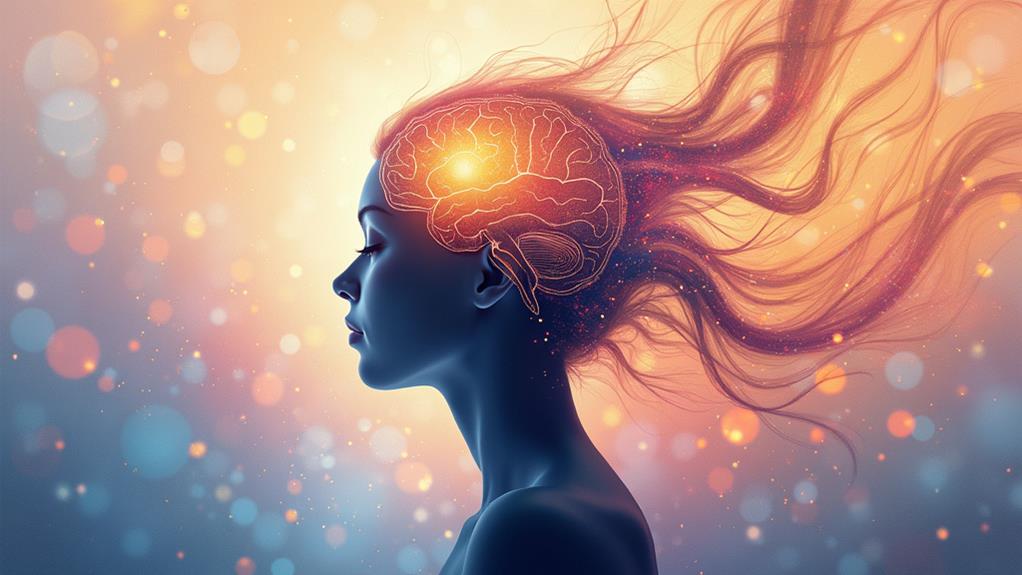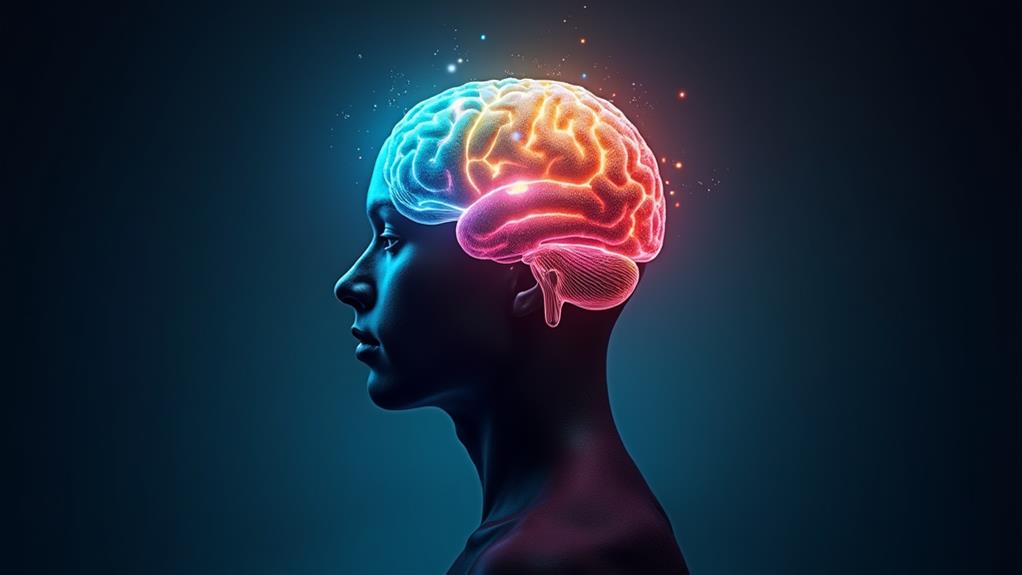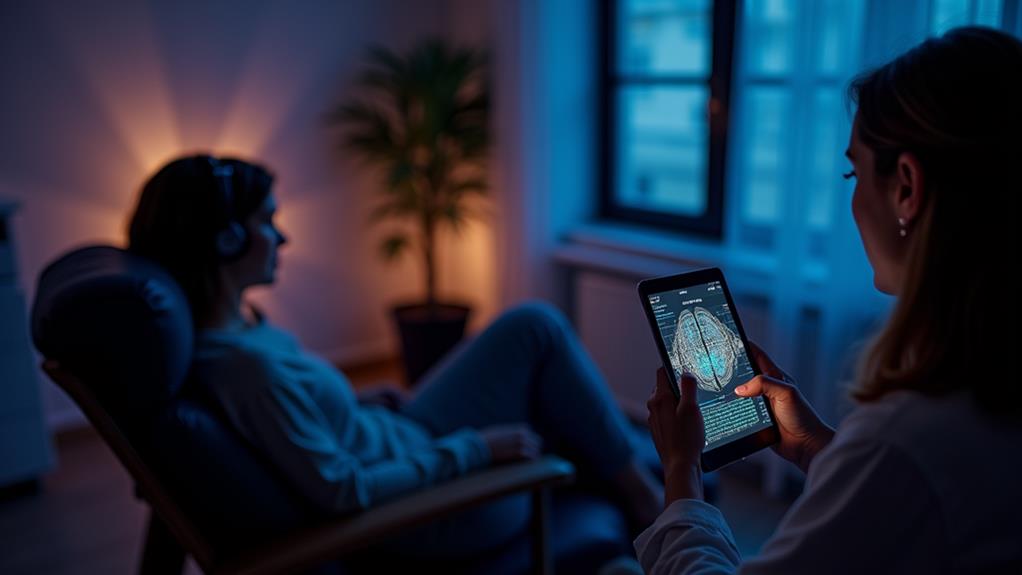
When you undergo hypnosis, your brain’s theta and delta frequencies play a vital role in deepening your trance state, neuro-frequencies and hypnosis making you more susceptible to suggestions. These lower frequency waves, especially theta waves ranging from 4-8 Hz, are necessary for achieving meditative states that facilitate behavior modification.
During hypnosis, an increase in theta and delta activity helps to enhance your relaxation and receptiveness, creating an ideal state for therapeutic interventions. Neuro-frequency manipulation via EEG-guided techniques allows hypnotists to customize their approach, optimizing therapeutic outcomes. By understanding and adjusting these frequencies, you can greatly improve your receptiveness to hypnotic suggestions, revealing deeper insights into your mind’s potential.
Understanding Brain Waves
You must grasp the basics of brain waves to fully appreciate how they underpin the hypnotic states. These waves, ranging from delta to gamma, correspond to different levels of consciousness and cognitive processing. Specifically, in hypnosis, the frequency of theta waves increases, indicating a deeper state of mind relaxation and suggestibility.
Brain Wave Basics
Most individuals seldom ponder on how their brain’s electrical activity influences their mental states, yet comprehending brain waves is fundamental to grasping how hypnosis operates. Brain waves are rhythmic electrical signals produced by your brain, critical for determining various mental states. These encompass beta, alpha, theta, delta, and gamma waves, each linked to specific activities and states of mind.
In the domain of hypnosis, brain wave states are pivotal. You’ll find that theta waves, in particular, play a vital role. These waves are associated with deep relaxation and the shift into a state where your subconscious mind becomes more accessible.
This theta frequency, typically ranging between 4 to 8 Hz, is often targeted in hypnosis to facilitate this deep, meditative state. It’s here, in this theta state, that hypnosis can effectively work to modify behaviors, perceptions, and possibly even deeply ingrained habits.
Understanding these patterns isn’t just academic; it’s practical. By recognizing how to guide brain wave activity into theta or delta frequencies, you or a hypnotist can more effectively induce states of deep relaxation and heightened suggestibility, essential for a successful hypnosis session.
Hypnotic State Frequencies
Why do specific brain wave frequencies become more prominent during hypnosis? During a hypnotic state, your brain’s activity shifts notably, showing a noticeable increase in theta wave patterns. These theta waves are vital as they facilitate a deeper relaxation and enhance your suggestibility. This isn’t just a casual shift; it’s a significant transformation that allows you to access your subconscious mind more effectively.
As you immerse further into hypnosis, theta waves dominate, leading to what can be described as a profound hypnotic state. This state isn’t just about being relaxed; it’s where your brain optimizes the conditions for receiving and processing suggestions at a subconscious level.
The presence of delta waves in the deepest stages of hypnosis underscores this, indicating an even more profound level of relaxation and receptiveness.
Interestingly, in highly hypnotizable individuals, an asymmetry in beta wave activity is observed across different hemispheres of the brain. This isn’t random. It highlights a unique neural response that facilitates heightened attention and cognitive processing, essential for a fully engaged hypnotic experience. Understanding these patterns in brain waves during hypnosis can greatly improve the effectiveness of therapeutic techniques.
Types of Brain Frequencies

As you explore the types of brain frequencies, you’ll find that each plays a distinctive role in hypnosis.
For instance, while beta waves signify your normal waking state, theta waves are essential for achieving deeper hypnotic states.
Understanding these variations can greatly enhance your grasp of how hypnosis impacts brain activity.
Brain Frequency Overview
Understanding the different types of brain frequencies is important for grasping how our minds function under various states of consciousness. Let’s explore the specifics of these frequencies and their implications.
Starting with beta waves, which oscillate between 14-40Hz, you’re dealing with the brain’s mode during active, alert phases and even stress. It’s your brain in its most engaged state, processing information rapidly.
On the flip side, alpha waves, which range from 7.5-14 Hz, denote a more relaxed state. Here, your brain slows down a bit—ideal for meditation or absorbing intuition without intense focus.
Now, theta waves, ranging from 4-7.5Hz, are particularly intriguing, especially when discussing hypnosis. These waves are predominant in states of deep meditation and hypnosis, where the subconscious begins to unfold. This frequency range is where profound creativity, insight, and deep subconscious activities emerge.
Lastly, delta waves, at 0.5-4Hz, occur during deep sleep or intense regenerative states, essential for healing and recovery. Meanwhile, gamma waves, existing above 30Hz, are linked to high-level cognitive functioning and bursts of insight.
Each frequency band represents a unique state of brain activity, important for understanding how our brains operate from moment to moment.
Impact on Hypnosis
Exploring the impact of brain frequencies on hypnosis, it becomes clear that specific waves like theta and delta are vital in deepening hypnotic states. You’ll find that these frequencies greatly influence your suggestibility during hypnotherapy sessions. When your brain enters the theta state, typically associated with deep relaxation and the onset of sleep, your subconscious mind becomes more accessible. This state allows for effective hypnotherapy interventions that can promote profound changes in behavior and perception.
The shift between alpha, theta, and delta waves is crucial. Initially, your brain might exhibit alpha waves, indicating a relaxed yet alert state. As you explore deeper into hypnosis, the movement towards theta and eventually delta waves occurs, each frequency facilitating a deeper level of trance. This progression is essential for hypnosis to effectively bypass the conscious mind’s usual barriers, reaching the more receptive subconscious layers.
Understanding and manipulating these brain wave frequencies can greatly improve the outcomes of hypnotherapy. By specifically targeting these states, therapists can enhance the receptivity of the mind to positive suggestions and therapeutic interventions. This tailored approach ensures that the subconscious mind is optimally prepared to absorb and integrate new, beneficial concepts and behaviors.
EEG and Hypnosis Correlation

As you explore the correlation between EEG patterns and hypnosis depth, it’s important to recognize that EEG spectrum analysis provides a detailed mapping of brain activity during hypnosis.
You’ll find that various brain regions exhibit distinct EEG patterns which correlate with the depth of hypnotic states, reinforcing the role of theta and alpha waves in deeper engagement.
This analysis is vital in distinguishing between hypnotizable individuals and those less susceptible, as marked by the variance in theta activity and resting alpha states.
EEG Patterns Identified
EEG patterns, important in distinguishing between hypnotizable and non-hypnotizable individuals, reveal varied responses during hypnosis. You’ll notice that hypnotizable subjects often demonstrate increased theta power and resting alpha activity. These EEG patterns are essential as they indicate a deeper engagement with the hypnotic process.
When you explore further into the EEG readings, it becomes apparent that theta brain waves are notably reduced during the hypnosis induction in highly suggestible individuals. This reduction contrasts with the general population, where theta activity doesn’t display such a marked decrease. This suggests that the capacity to enter a hypnotic state may be linked to how one’s brain decreases theta activity in response to hypnosis.
Moreover, as the session progresses, there’s a gradual shift towards beta waves, particularly during the reorientation phase. This shift is observed in the EEG patterns as beta activity increases, signaling a return to full alertness and engagement with the external environment.
Understanding these EEG dynamics—theta reduction, sustained alpha frequency, and the beta wave increase—provides you with a clearer picture of the neurophysiological underpinnings that characterize the hypnotic state in different individuals.
Hypnosis Depth Analysis
Building on the insights from EEG patterns in earlier discussions, it’s evident that understanding the extent of hypnosis requires an analysis of specific brain wave activities. You’ve learned that different brain wave frequencies, especially theta, delta, and beta, are vital indicators of your state during a hypnotic trance.
When you explore further into hypnosis, theta waves become predominant, signaling a progression into a deeper state of relaxation and enhanced suggestibility. This is where you reach a profound hypnotic state.
In even deeper stages, delta wave patterns emerge, reflecting a state of profound relaxation, often associated with a decreased awareness of the external environment. This state is essential for therapeutic interventions where high suggestibility can facilitate significant psychological changes.
Conversely, when you’re in a fully engaged hypnotic state, beta waves dominate. This indicates that your mind is actively processing information and maintaining focus. It’s a state less about relaxation and more about heightened concentration and alertness within the trance.
Understanding these neural substrates through EEG spectrum analysis helps in accurately assessing the depth of hypnosis. By monitoring these brain wave activities, practitioners can customize hypnotic techniques to achieve desired therapeutic outcomes, ensuring effectiveness and safety in hypnotic practice.
Enhancing Hypnotic Susceptibility

You can enhance your hypnotic susceptibility through targeted training techniques and brainwave synchronization. These methods aim to adjust your brain’s frequency patterns to facilitate deeper hypnotic states, with a particular focus on increasing theta and alpha wave activity. By employing EEG feedback and specific mental exercises, you’re able to more effectively align your brainwave patterns with those observed in highly hypnotizable individuals.
Training Techniques
Improving your ability to enter hypnotic states involves specific training techniques that target brain wave adjustments. By focusing on inducing precise brain wave states, you can notably increase your hypnotic susceptibility. Techniques such as visualization and relaxation are pivotal in guiding your mind to achieve the desired frequency changes. Visualization, for example, helps in shaping your brain’s activity towards the theta and delta states, necessary for deeper levels of hypnosis.
To begin, relaxation plays a foundational role. It’s not just about physical ease but also mental tranquility. This state reduces higher frequency beta waves, commonly associated with active thought processes, and encourages the emergence of alpha waves, which bridge you to deeper states. Consistent practice of these techniques conditions your brain to shift more smoothly between these frequencies.
Furthermore, the repetitive engagement with these training methods enhances your overall receptiveness to hypnosis. Each session where you practice visualization or relaxation not only deepens the individual experience but also cumulatively conditions your neural pathways, improving your ability to sink into profound hypnotic states swiftly and effectively. These tailored exercises are essential in your journey towards becoming highly susceptible to hypnosis, leveraging brain wave modulation to your advantage.
Brainwave Synchronization
Following the methods outlined for training your brain to adjust to different frequencies, we now focus on how brainwave synchronization can further increase your susceptibility to hypnosis. This process, essential for enhancing hypnotic susceptibility, involves aligning your neural oscillations with specific external stimuli. Through techniques like binaural beats and visual entrainment, synchronization of your brainwaves becomes attainable, leading to more profound hypnotic states.
Studies indicate that synchronized brainwave patterns during hypnosis heighten suggestibility and receptiveness. When your brainwaves are in harmony, particularly in the theta and delta ranges, your ability to absorb and respond to suggestions improves significantly. This entrainment not only facilitates smoother and quicker hypnotic inductions but also deepens the trance states, making the hypnotic experience more intense and beneficial.
Applications of Hypnotic States

In exploring the applications of hypnotic states, you’ll find that therapeutic hypnosis offers significant benefits, particularly in mental health treatment where modulation of brain wave frequencies can alleviate symptoms of anxiety and depression.
Enhancing creative processes is another key application, as increased theta wave activity during hypnosis fosters enhanced creativity and problem-solving abilities.
These applications underscore the potential of tailored hypnotic techniques to harness specific brain wave patterns for desired outcomes.
Therapeutic Hypnosis Benefits
Through therapeutic hypnosis, individuals can effectively address and overcome persistent negative thoughts and anxieties by tapping into hypnotic brain wave states. When you’re under therapeutic hypnosis, your brain wave frequencies are skillfully manipulated to access the subconscious mind, an essential area for making significant changes in behavior and emotional responses.
This form of therapy leverages your brain’s natural wave patterns, shifting mainly to theta waves, known for their role in deeper levels of relaxation and medium trance states.
In this medium trance, your suggestibility increases, allowing for the effective implantation of positive suggestions and the dismantling of negative thought patterns. The hypnotist or therapist carefully guides your brain waves from a normal, alert beta state to a more receptive theta state, where therapeutic work becomes highly impactful.
This shift isn’t random but a meticulously controlled process, ensuring that changes occur at the deepest subconscious level.
Optimal therapy states are chosen based on the specific brain wave frequencies best suited for the therapeutic goals. This precision in brain wave manipulation during hypnotherapy sessions is what makes therapeutic hypnosis a potent tool for personal growth and overcoming deep-seated anxieties and behaviors.
Enhancing Creative Processes
As we explore the applications of hypnotic states further, consider how these altered states, particularly through the use of theta and delta brain waves, greatly enhance creative processes.
Theta brain waves in hypnosis stimulate creative processes akin to dream states, fostering innovative thinking and problem-solving. You’re tapping into a subconscious wellspring, allowing for the free flow of ideas that might otherwise be stifled by the conscious mind’s analytical tendencies.
Moreover, delta brain waves, often prominent during deep meditation practices, can deepen this creative enhancement. These frequencies access deeper levels of consciousness, which isn’t typically reachable in a normal waking state. This access can lead to profound insights and bursts of creativity, seemingly coming from a ‘deeper’ place.
Incorporating meditation practices that stimulate these specific brain wave frequencies can further enhance your creative abilities. The deliberate induction of alpha and theta waves during such practices not only relaxes your mind but also primes it for the generation of novel ideas.
The overlap in brain wave patterns between dream states, meditative states, and hypnotic states underlines a significant connection between these altered states of consciousness and heightened creative capacities. This mechanism is a key influencer in creative problem-solving and promoting innovative approaches during hypnosis.
Frequently Asked Questions
What Frequency Is the Brain During Hypnosis?
Imagine you’re drifting into a deep, peaceful state. During this process, your brain typically operates within the theta wave range of 4-8 Hz, indicating a deep relaxation and heightened suggestibility.
This shift from your usual beta activity, which is more common in full alertness, to theta allows for a profound hypnotic experience.
In deeper states, you might even touch upon delta frequencies, further enhancing the hypnotic effect.
Which Frequency Is Best for Hypnosis?
You’re likely searching for the most effective brain wave frequency for deep relaxation and suggestibility during hypnosis.
Theta waves, which range from 4-8 Hz, are generally considered the best for this purpose. They allow you to reach a medium trance state where you’re more open to suggestions, facilitating significant therapeutic changes.
In essence, targeting theta waves during hypnosis sessions can help in accessing your subconscious mind and promoting the desired positive transformations.
What Brain Wavelength Is Hypnosis?
The brain wavelength important in hypnosis is the theta wave. Typically ranging from 4 to 8 Hz, these waves are essential when you’re entering a hypnotic state. They help deepen relaxation and enhance suggestibility, making them ideal for effective hypnosis.
While other brainwaves like alpha and delta play roles in varying states of consciousness during hypnosis, theta waves are specifically linked to the process of achieving and maintaining deep hypnotic states.
Can You Rewire Your Brain With Hypnosis?
Yes, you can gently reshape your mind’s landscape through hypnosis. This process allows you to access your subconscious, introducing positive suggestions that form new neural pathways. By engaging in hypnotherapy, you’re taking advantage of your brain’s neuroplastic abilities, effectively altering entrenched thought patterns and behaviors.
This rewiring leads to enduring changes, enhancing your overall well-being and mental framework. So, embracing hypnosis could be a transformative step towards personal growth and healing.
Conclusion
As you explore deeper into the domain of self-hypnosis, remember, “knowledge is power.” By understanding and controlling your brain’s neuro-frequencies, from theta’s calmness to beta’s attentiveness, you improve your mental sharpness and intensify hypnotic states. This expertise not only expands the uses of hypnosis in healing environments but also enhances your individual mental well-being voyage. Harnessing these frequencies is not just about relaxation—it’s about revealing a higher potential of your cognitive and emotional health.
Take the Next Step Purchase A Copy
Mark’s most controversial book “Secret Power” is available on Amazon in paperback or Kindle. Be sure to purchase two copies and give one to a friend, you do reap what you sow!

Make An Appointment
Do not be afraid to reach out to me, Mark , to assist you in any issues you might have. Need a good listener or someone to confidentially talk too? . Life Coaching is 45 minute session, once a week.
Self-Hypnosis is taught in one session, individual sessions or in a group, and lasts a lifetime. Most Hypnotherapy sessions including Age regression last 2 hours and EFT Sessions are usually handled with a one hour session
To make an appointment, first listen to the Pre-talk and fill out the Complementary Healthcare Provider Disclosure. The use the Contact Form to request an appointment with, Mark, The Bohol Hypnosis Expert.
Self-help downloads are available to help you with specific problems. The self-hypnosis program to teach you how to self-hypnotize yourself is available here.





